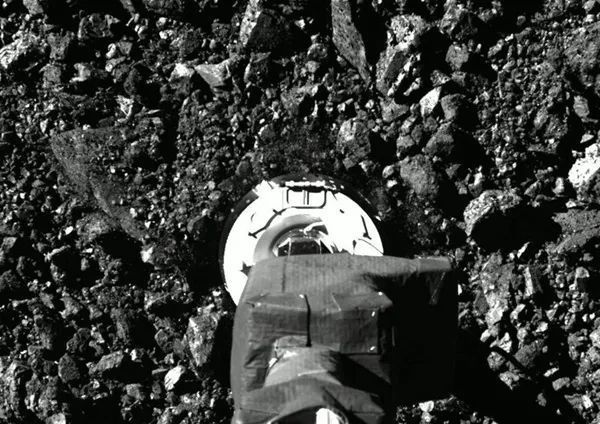Monday · Knowing the ancient and the present | Tuesday · Shepherd's Column
Wednesday · Space exploration | Thursday · Observation Guide
Friday · Deep Space Exploration | Saturday · Chayu Xingyu | Sunday · Video celestial phenomena
Translation: Lei Fontu
Proofreading: Shepherd Astronomy Proofreading Group
Later stage: Hu Yongwei
Responsible editor: Mao Mingyuan
Derived from astronomy.com
2022 is undoubtedly an exciting year for astronomy – from the opening of the James Webb Space Telescope to NASA's impact on an asteroid – 2023 looks like a lot less impressive than 2023.
However, this is not the case. From exploration of the entire solar system to new breakthroughs in commercial space travel, space missions in 2023 are still exciting!
1. The asteroid Bennu sample returns to Earth
Back in 2016, NASA launched the OSIRIS-REx mission. The spacecraft arrived on the asteroid Bennu in October 2020 to collect rock samples. It is estimated that OSIRIS-REx will return to Earth with samples on September 24, 2023.
Among the many asteroids in the solar system, Bennu is also a small man. It is about the same width as the height of the Empire State Building (about 500 meters). It is worth noting that according to NASA, it has a 1 in 1750 chance of crashing into Earth when approaching it at the end of the 22nd century.
As 2023 approaches, Boeing and SpaceX will continue to compete for NASA's Commercial Crew Program (CCP) to send humans into space. In February, SpaceX will attempt a sixth launch for CCP, sending four astronauts to the International Space Station.

OSIRIS-REx's photograph of specimen collection
Credits:NASA/Goddard
2. SpaceX and Boeing send humans into space
As 2023 approaches, Boeing and SpaceX will continue to compete for NASA's Commercial Crew Program (CCP) to send humans into space. In February, SpaceX will attempt a sixth launch for CCP, sending four astronauts to the International Space Station.
Boeing, meanwhile, is slightly behind SpaceX in launches, but will also attempt its first launch of its manned Starliner program in April, which will include two NASA astronauts. The launch is the final test Boeing needs to pass before using Starliner to regularly send astronauts to the International Space Station.
SpaceX's Crew Dragon has proven itself on multiple missions.
Credits: SpaceX
3. Several countries rushed to the moon
Russia has not sent a probe to the lunar surface since Luna 24 in 1976, but that doesn't mean it has completely abandoned the field. By the end of 2022, Russia plans to launch their Luna 25 lander in 2023. The spacecraft will attempt to land near the Boguslausky crater in the south pole region of the moon to study the components of the moon's polar outer atmosphere.
India has similar goals, and it plans to launch its third lunar mission in mid-to-late 2023. The launch of Chandrayaan-3 was originally scheduled for August 2022, but was delayed to complete more important tests. If successful, Chandrayaan-3 will land on high ground near the moon's south pole.
Finally, two lunar landers will be launched from the United States in 2023. Houston-based Intuitive Machines' Nova-C spacecraft will take off in March 2023. If successful, it would be the first American spacecraft to land on the moon since Apollo 17 in 1972. Meanwhile, Astrobotic Technology's Peregrine Falcon lunar lander is tentatively scheduled to land on the lunar surface in the first quarter of 2023. The main mission goal of Peregrine Falcon will be to study the moon's outer atmosphere, magnetic field and other characteristics.
4. ASIA'S JUICE MISSION TO EUROPE
In April 2023, the European Space Agency will send their Jupiter icy satellite probe JUICE to Jupiter. After entering orbit around Jupiter in 2031, JUICE will make detailed observations of the gas giant's three moons with large oceans. Garnimet (Europa), Europa (Europa) and Callisto (Europa). These observations will allow astronomers to study the three moons, as well as Jupiter's environment, in unprecedented detail.
JUICE WILL FLY BY GALNIMET AND CALLISTO AT LEAST 12 TIMES, RESPECTIVELY, AND EUROPA TWICE. In the final phase of its expected two-year mission, JUICE will orbit Garneymet for about 9 months to study the satellite in more depth. This will mark the first time a spacecraft orbits another planetary moon in the solar system other than the moon.
Credits: ESA
5. SpaceX launched its Starship into orbit
Over the past few years, SpaceX has made a name for itself in the aerospace industry. Now, the company will try to make more history.
Sometime in early 2023, whether it's late February or March, SpaceX will try to launch its second-stage spacecraft, the Starship, into orbit using its super-heavy first-stage rocket booster. According to SpaceX, the two are collectively referred to as "Starship," which the company plans to use in the future as a fully reusable cargo and manned transportation system.
The company has planned several uses for Starship, including putting satellites into Earth orbit and landing cargo and personnel on the moon and Mars. Launching Starship into orbit around Earth is just the first test to see if it can handle these future missions.
So when you look up at the stars at some point in 2023, you're probably witnessing a breakthrough in space exploration.
Life comes first
Credits: Dima Zel/Shutterstock
Thanks for reading